The Painted Stork (Mycteria leucocephala) is a striking wading bird renowned for its vivid plumage and graceful demeanor.
Found primarily in the wetlands of South and Southeast Asia, these storks inhabit freshwater lakes, marshes, and shallow ponds where they forage for their staple diet of fish, crustaceans, and amphibians.
Characterized by its distinctive pink and white plumage with black wing feathers, the Painted Stork boasts a long, slender bill designed for efficiently capturing prey in the water.
Standing tall on long legs, these birds are often observed wading through shallow waters with elegant strides, their imposing wingspan adding to their majestic presence.
With a notable communal nesting behavior, Painted Storks build large stick nests in colonies, typically atop trees or in reed beds, fostering community and cooperation among these magnificent avians.
Physical Characteristics of Painted Stork
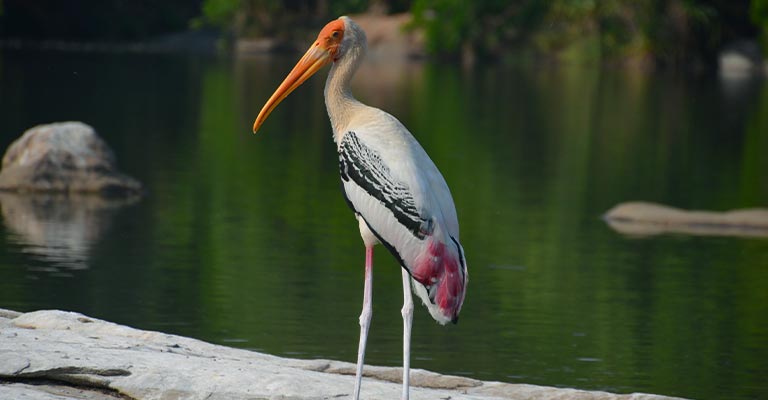
The Painted Stork (Mycteria leucocephala) possesses several distinct physical characteristics that aid in its identification, making it a striking and easily recognizable bird species.
Plumage
The most striking feature of the Painted Stork is its vivid plumage. Adults display predominantly white plumage on their body, contrasting with bold patches of pink on their wings, lower back, and tail.
This coloration is particularly noticeable during flight, as the pink and white feathers create a stunning visual display against the backdrop of the sky.
Black Wing Feathers
One of the most distinguishing features of the Painted Stork is the presence of black feathers on its wings.
These black feathers form a prominent contrast against the bird’s predominantly white and pink plumage, creating a striking pattern that is easily identifiable, especially when the stork is in flight.
Long, Decurved Bill
Painted Storks are equipped with long, slender bills that curve slightly downward.
This distinctive bill shape is well-adapted for capturing fish and other aquatic prey in shallow waters, allowing the stork to probe efficiently for food.
Pink Facial Skin
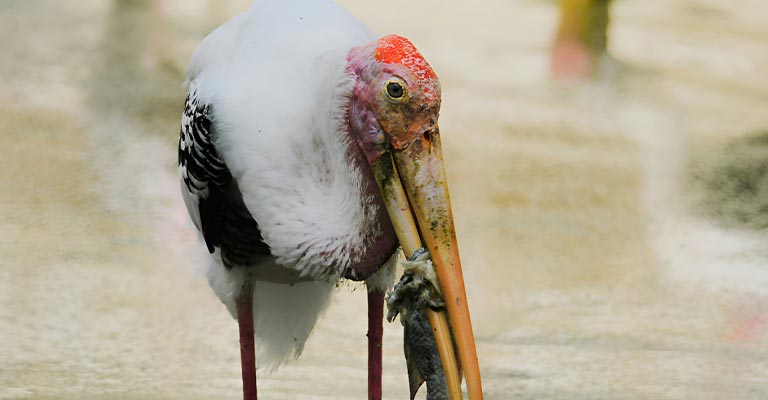
Another notable characteristic of the Painted Stork is its pink facial skin. Adult birds have vibrant pink skin around their eyes and on their bare throat pouch, adding to their overall colorful appearance.
Long Legs
Painted Storks have long, slender legs that are pale pink or grayish. These legs are adapted for wading through shallow water, allowing the stork to easily navigate its wetland habitat while foraging for food.
Imposing Size
Painted Storks are large birds, with adults typically measuring between 85 and 102 centimeters (33 to 40 inches) in length. Their impressive size, coupled with their striking plumage, makes them stand out in their natural habitat.
Wing Span
Painted Storks exhibit a significant wingspan when in flight, typically ranging between 150 to 160 centimeters (59 to 63 inches).
This expansive wingspan contributes to their graceful and majestic appearance as they soar.
Nesting Behavior
During the breeding season, Painted Storks can be observed engaging in communal nesting behavior, often building large stick nests in colonies atop trees or in reed beds.
Seeing several storks nesting together nearby is a characteristic behavior that helps identify this species during the breeding season.
Overall, its vibrant plumage, distinctive bill shape, long legs, and communal nesting behavior make the Painted Stork a unique and readily identifiable bird species in its native wetland habitats.
Taxonomy of Painted Stork
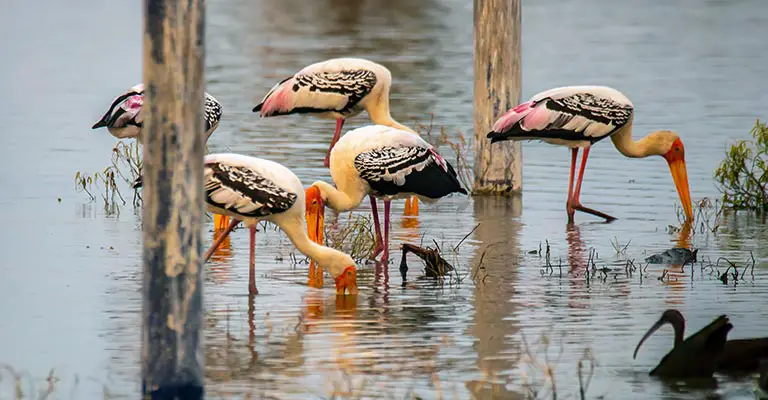
Let’s check out a table detailing the taxonomy of the Painted Stork:
| Domain | Eukaryota |
| Kingdom | Animalia |
| Phylum | Chordata |
| Class | Aves |
| Clade | Aequornithes |
| Order | Ciconiiformes (Bonaparte, 1854) |
| Family | Ciconiidae |
| Genus | Mycteria |
| Species | M. leucocephala |
The Painted Stork (Mycteria leucocephala) belongs to the kingdom Animalia, phylum Chordata, class Aves, order Ciconiiformes, family Ciconiidae. The family Ciconiidae is classified under the subfamily Mycteriinae.
The genus Mycteria comprises three species of large wading birds, among which the Painted Stork is the most recognizable.
Its species name, leucocephala, is derived from Greek roots meaning “white-headed,” referencing the bird’s distinctively colored head.
This taxonomy categorizes the Painted Stork among other storks and closely related species, highlighting its evolutionary relationships within the broader context of avian diversity.
Common Food of Painted Stork
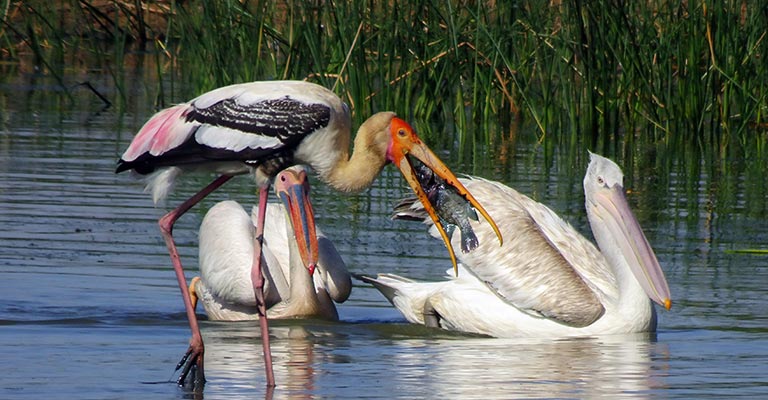
The Painted Stork (Mycteria leucocephala) primarily feeds on a diet of various aquatic organisms in freshwater habitats. Their typical food habits include:
- Fish: Painted Storks predominantly prey on fish species, such as small freshwater fish, which they catch by wading through shallow waters and using their long bills to snatch them up.
- Crustaceans: Crustaceans, including crabs, shrimp, and crayfish, are also a significant part of the Painted Stork’s diet. They use their sharp bills to probe the muddy substrate and capture these crustaceans.
- Amphibians: Painted Storks occasionally consume amphibians such as frogs and tadpoles, particularly during the breeding season when these organisms are more abundant in their wetland habitats.
- Insects: While less common, Painted Storks may also feed on insects such as dragonflies, beetles, and aquatic insects, especially when other food sources are scarce.
- Aquatic Invertebrates: Additionally, they may consume various aquatic invertebrates like mollusks and worms, providing a diverse and balanced diet essential for their survival and reproductive success in their wetland ecosystems.
Painted Stork Life History
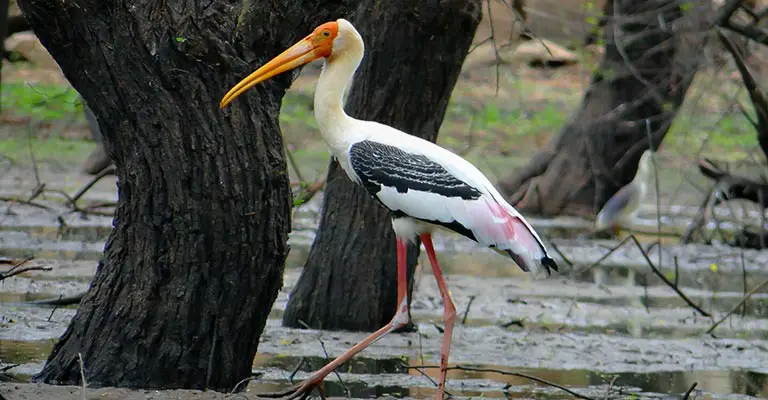
The Painted Stork (Mycteria leucocephala) is a captivating wading bird known for its vibrant plumage and graceful presence in South and Southeast Asia wetland habitats.
From its hunting habits to nesting behavior and its role in conservation efforts, the life history of the Painted Stork reveals a fascinating interplay between adaptation and environmental challenges.
Hunting Habit
Painted Storks are adept hunters, primarily targeting fish, crustaceans, amphibians, and other tiny aquatic organisms.
With their long, slender bills and keen eyesight, they wade through shallow waters, using their bills to probe the substrate and snatch prey with swift strikes.
Habitat
These storks inhabit various wetland environments, including freshwater lakes, marshes, ponds, and mangrove swamps. They prefer areas with ample vegetation for nesting and feeding opportunities.
Range Map
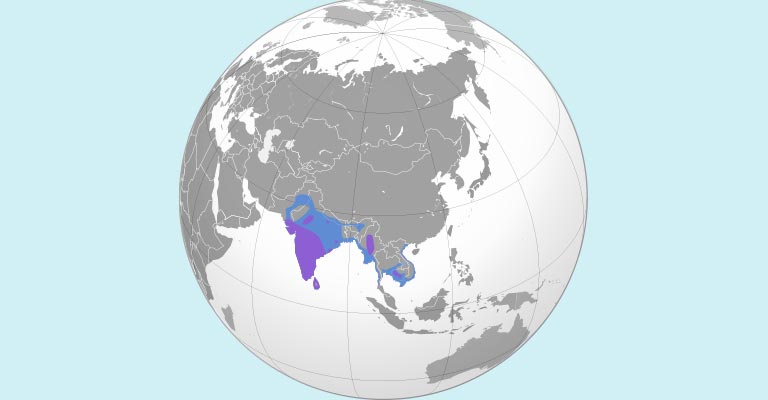
The range of the Painted Stork extends from the Indian subcontinent through Southeast Asia, including countries like India, Sri Lanka, Bangladesh, Myanmar, Thailand, and Cambodia.
They are also found in parts of Indonesia and the Philippines.
Nesting
During the breeding season, Painted Storks form colonies where they build large stick nests atop trees or in reed beds.
Nest construction is communal, with both male and female storks participating in building and maintenance.
Here’s a table detailing the nesting details of the Painted Stork:
| Nesting Detail | Description |
| Clutch Size | 2-5 eggs |
| Number of Broods | Typically one brood per breeding season |
| Egg Length | Approximately 7.5-8.5 centimeters (3-3.3 inches) |
| Egg Width | Approximately 4.5-5.5 centimeters (1.8-2.2 inches) |
| Incubation Period | Around 25-32 days |
| Nestling Period | Approximately 60-70 days |
| Egg Description | Smooth, oval-shaped with a pale bluish-green coloration |
Breeding
Breeding pairs engage in elaborate courtship displays, including bill-clattering and wing-flapping. Females typically lay 2-5 eggs, which are incubated for about a month. Both parents share incubation duties and care for the chicks.
Diseases
Painted Storks are susceptible to various diseases, including avian botulism, avian influenza, and parasitic infections. These diseases can affect individual birds or entire colonies, leading to mortality and population declines.
Treatment
Conservationists and wildlife veterinarians work to monitor and treat diseases in Painted Stork populations. This includes surveillance, vaccination programs, and medical care for sick or injured birds.
Conservation
The Painted Stork faces habitat loss, pollution, and human disturbance threats.
Conservation efforts focus on habitat protection, mitigating human-wildlife conflicts, and raising awareness about the importance of preserving wetland ecosystems for the survival of this iconic species.
Collaborative initiatives involving governments, NGOs, and local communities are crucial for ensuring the long-term conservation of the Painted Stork and its habitat.
10 Fun Facts About Painted Stork
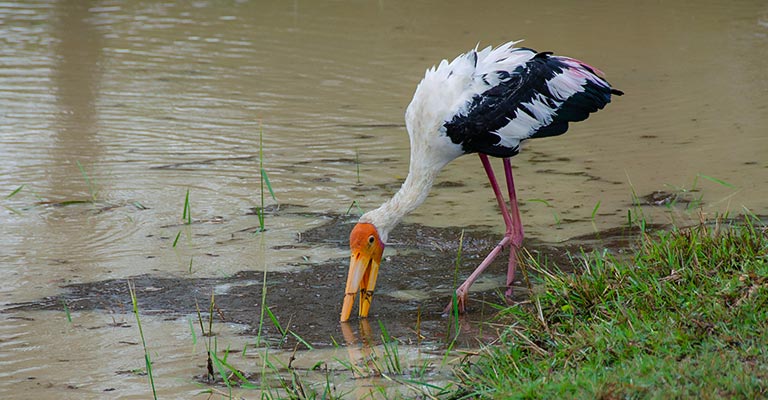
The Painted Stork (Mycteria leucocephala) is a fascinating bird species known for its striking appearance and exciting behaviors. Here are 10 fun facts about the Painted Stork:
- Vivid Plumage: Painted Storks boast vibrant pink and white plumage, making them one of the most colorful stork species in the world.
- Black Wing Feathers: These storks have distinctive black feathers on their wings, creating a striking contrast against their predominantly white plumage.
- Long Legs: Painted Storks have long, slender legs adapted for wading through shallow water while hunting for food.
- Social Nesting: During the breeding season, Painted Storks form large colonies where they build communal stick nests atop trees or in reed beds.
- Courtship Displays: Breeding pairs engage in elaborate courtship displays, including bill-clattering and wing-flapping, to strengthen their bond.
- Migratory Behavior: While some populations are sedentary, others undertake seasonal migrations for suitable feeding and breeding grounds.
- Cooperative Foraging: Painted Storks often forage in groups, using collaborative strategies to catch fish and other prey in shallow waters.
- Noisy Chicks: Painted Stork chicks are known for their loud, raucous calls, which they use to communicate with their parents and siblings.
- Longevity: Painted Storks can live for up to 20 years in the wild, while individuals in captivity may live even longer under optimal conditions.
- Conservation Status: While not currently considered endangered, Painted Storks face threats from habitat loss, pollution, and human disturbance, highlighting the importance of conservation efforts to protect this iconic species and its wetland habitats.
Wrapping Up
The Painted Stork is a captivating symbol of the diverse and fragile wetland ecosystems it calls home.
Its vibrant plumage, graceful movements, and communal nesting behavior depict resilience and adaptability to environmental challenges.
From its cooperative foraging strategies to its elaborate courtship displays, this iconic bird species offers valuable insights into the interconnectedness of life within wetlands.
However, as human activities continue to threaten these vital habitats, conservation efforts are more crucial than ever to ensure the survival of the Painted Stork and the myriad of other species that rely on these ecosystems for their existence.
Through awareness, education, and collaborative action, we can strive to protect and preserve the natural wonders embodied by the Painted Stork for generations to come.